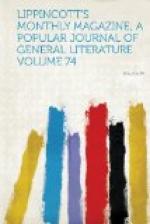Lord Fitzwilliam was a somewhat eccentric person. His nearest relation had displeased him by some very trivial offence, such as coming down late for dinner, so he determined to leave his estate to his distant cousin, Lord Pembroke. Falling ill, Lord Fitzwilliam, desired that Lord Pembroke might be summoned from London. Word came back that it was unfortunately impossible for him to leave England immediately. Presently news arrived from Dublin that Lord Fitzwilliam was dead, and had bequeathed all—the property is now three hundred and fifty thousand dollars a year—to Lord Pembroke, with remainder to his second son. By the death of the late Lord Pembroke the English and Irish properties have become united, and are to-day worth not less than six hundred thousand dollars a year! It is this young nobleman who has lately written The Earl and The Doctor.
REGINALD WYNFORD.
FOOTNOTES:
[Footnote 1: The Fitzgeralds, of which family the duke of Leinster is chief, became Protestant in 1611, when George, sixteenth earl of Kildare, coming to the title and estates when eight years old, was given in ward, according to the custom of the time, to the duke of Lenox (then lord privy seal), who bred him a Protestant.]
[Footnote 2: In June, 1798, the corpse of Lord Edward Fitzgerald was conveyed from the jail of Newgate and entombed in St. Werburgh’s church, Dublin, until the times would admit of their being removed to the family vault at Kildare. “A guard,” says his brother, “was to have attended at Newgate the night of my poor brother’s burial, in order to provide against all interruption from the different guards and patrols in the streets: it never arrived, which caused the funeral to be several times stopped on its way, so that the funeral did not take place until nearly two in the morning, and the people attending were obliged to stay in church until a pass could be procured to permit them to go out.”]
[Footnote 3: Lord Charlemont had a seat called Marino, beautifully situated within a few miles of Dublin. There is within the grounds an exquisite building erected from designs of Sir William Chambers. It is a small villa, in its arrangements suggesting a maison de joie. The furniture is just as it was, and although sadly out of repair, the visitor can easily judge how exquisite the place must once have been. There is a superb mantelpiece, richly mounted in bronze and inlaid with lapis lazuli.]




